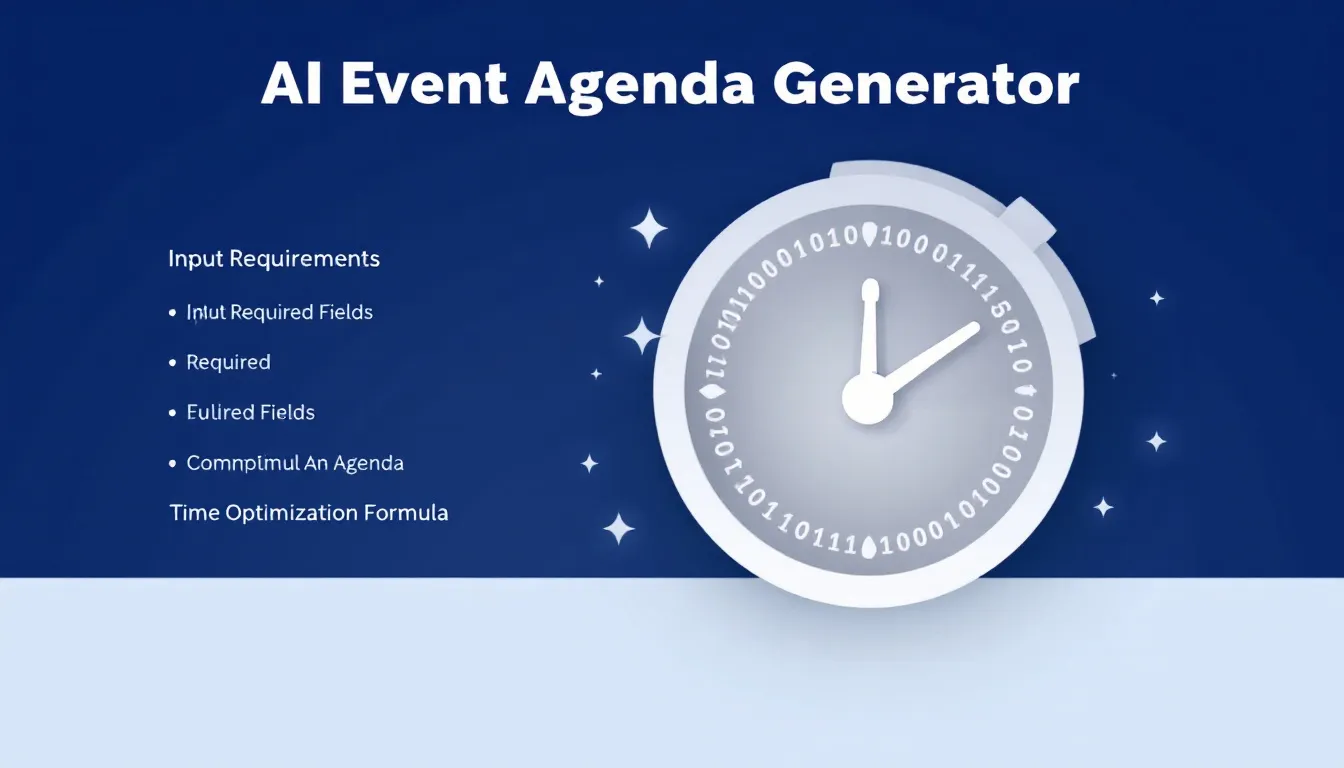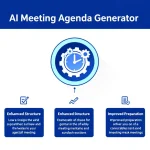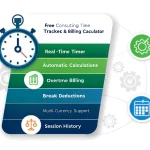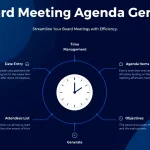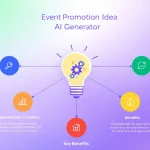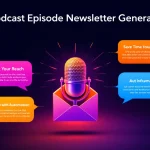AI Event Agenda Generator
Is this tool helpful?
How to Use the AI Event Agenda Generator Effectively
Step-by-Step Guide to Creating Your Event Schedule
You can quickly generate a professional event agenda by completing the form with essential details. Here’s how to fill out each field using examples different from the form:
- Event Name: Enter your full event title, such as “International Renewable Energy Summit” or “Customer Experience Leadership Forum”.
- Event Date: Choose the date in YYYY-MM-DD format. For instance, 2024-11-15 or 2025-02-20. You may specify multiple dates for multi-day events.
- Start and End Times: Use 24-hour time like 08:30 for 8:30 AM or 16:45 for 4:45 PM.
- Number of Sessions: Enter how many sessions your event will include, like 7 or 4.
- Session Titles/Topics: List one session title per line. Examples: “Sustainable City Planning”, “Advances in AI Ethics”.
- Speakers (Optional): Add names of speakers, one per line, such as “Dr. Amelia Chen” or “Carlos Martinez”.
- Break Preferences (Optional): Specify break timing like “10min break every 3 sessions” or “30min lunch at 13:00”.
What Is the AI Event Agenda Generator and Why Use It?
The AI Event Agenda Generator is a tool designed to simplify your event planning by creating detailed, professional schedules in moments. It uses artificial intelligence to balance session times and breaks, ensuring smooth flow throughout your conference, workshop, or seminar.
Key Benefits of Using This Event Scheduling Tool
- Save Time: Cuts agenda creation time by up to 75% compared to manual planning.
- Optimize Flow: Automatically allocates session durations and breaks for ideal pacing.
- Enhance Professionalism: Produces consistent, clear, and easy-to-read agendas.
- Prevent Conflicts: Avoids overlapping sessions and scheduling errors.
Practical Usage for Event Planners and Organizers
You’ll use this tool to input your event details, and it generates a polished agenda you can share with participants or print. This makes it ideal for various event types:
- Conferences: Manage multiple sessions and speakers spanning a full day or multiple days.
- Workshops: Organize modular training sessions with breaks and networking times included.
- Corporate Meetings: Create structured agendas for board meetings, planning sessions, or retreats.
- Virtual and Hybrid Events: Incorporate time zones and virtual session links for remote participants.
Example Calculations for Scheduling Sessions and Breaks
Here’s how the AI calculates key timings to optimize your event schedule:
$$ \text{Session Duration} = \frac{\text{Total Event Time} – \text{Total Break Time}}{\text{Number of Sessions}} $$For break scheduling, it uses:
$$ \text{Break Interval} = \frac{\text{Total Sessions}}{\text{Number of Breaks}} $$Example: For a 7-hour event with 5 sessions and 60 minutes of breaks, the session duration is:
$$ \frac{420 \text{ minutes} – 60 \text{ minutes}}{5} = 72 \text{ minutes per session} $$How the AI Event Agenda Generator Solves Common Planning Challenges
Time Management
Balancing session lengths and breaks ensures your event runs smoothly without overruns or gaps. The AI automatically adjusts times to fit your input, reducing the risk of late sessions or lunch breaks.
Break Optimization
Breaks maximize attendee engagement and focus. The generator spaces breaks evenly using this formula:
$$ \text{Break Length} = \frac{\text{Total Break Time}}{\text{Number of Breaks}} \times \text{Engagement Factor} $$This keeps participants refreshed and improves overall satisfaction.
Common Use Cases for This Event Scheduling Tool
Conference Example
- Event: “Global Health Innovations Summit”
- Hours: 09:00 – 18:00
- Sessions: 8 keynotes and panels
- Breaks: 2 coffee breaks (15 min each), 1 lunch break (60 min)
- The AI schedules sessions to maximize knowledge retention and networking.
Workshop Series Example
- Event: “Entrepreneurship Bootcamp”
- Format: 4 half-day workshops
- Sessions: 5 modules per workshop
- Breaks: Integrated short breaks and longer lunch sessions
- Schedules account for multiple time zones for international participants.
Frequently Asked Questions About the AI Event Agenda Generator
Can I customize session durations for different presentation types?
Yes, you can specify varied durations for keynotes, workshops, and panel discussions by listing accurate session lengths in the session details.
How does the tool handle multiple tracks or parallel sessions?
The generator creates separate agendas for each track and ensures no timing conflicts between shared resources like rooms or speakers.
Is this tool suitable for virtual or hybrid events?
Yes, it supports virtual formats and includes features for time zone conversions and virtual session links.
Can I edit the agenda after it’s generated?
You can easily update the agenda by changing the input fields and regenerating your schedule any time.
Can I save multiple versions of an agenda?
Yes, you can generate, save, and compare different schedule versions to select the most effective plan.
Does the tool support multiple time zones?
Yes, you can generate agendas displaying times for various time zones, ideal for global events.
What export options are available for the generated agenda?
You can export your agenda as PDF, Word, Excel, or digital calendar files for easy sharing and printing.
Can I share the agenda directly with attendees?
Yes, share your agenda via email, generate shareable links, or embed it directly onto your event website.
Is it possible to customize branding elements in the agenda?
You can personalize colors, logos, and layout styles to match your event’s branding for a cohesive look.
Important Disclaimer
The calculations, results, and content provided by our tools are not guaranteed to be accurate, complete, or reliable. Users are responsible for verifying and interpreting the results. Our content and tools may contain errors, biases, or inconsistencies. Do not enter personal data, sensitive information, or personally identifiable information in our web forms or tools. Such data entry violates our terms of service and may result in unauthorized disclosure to third parties. We reserve the right to save inputs and outputs from our tools for the purposes of error debugging, bias identification, and performance improvement. External companies providing AI models used in our tools may also save and process data in accordance with their own policies. By using our tools, you consent to this data collection and processing. We reserve the right to limit the usage of our tools based on current usability factors.
